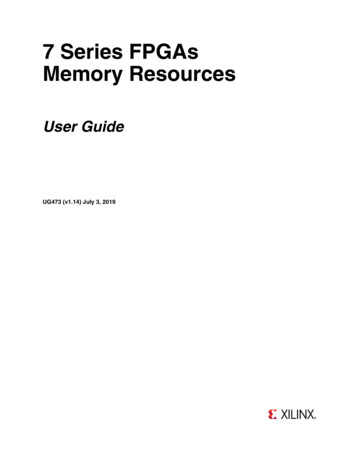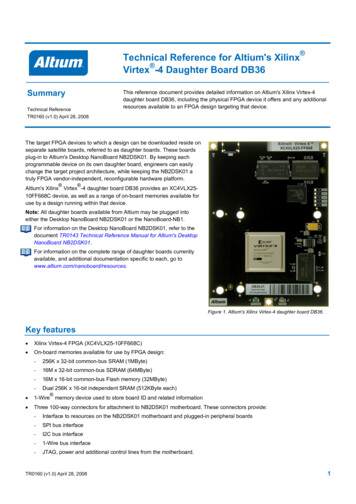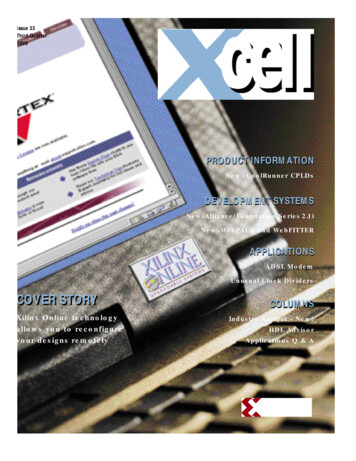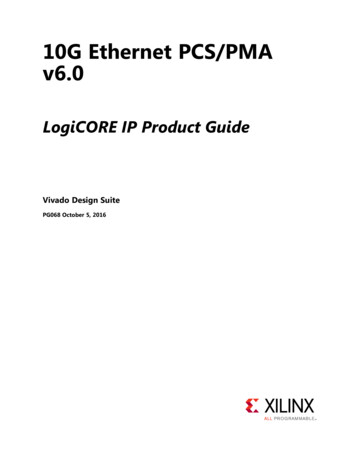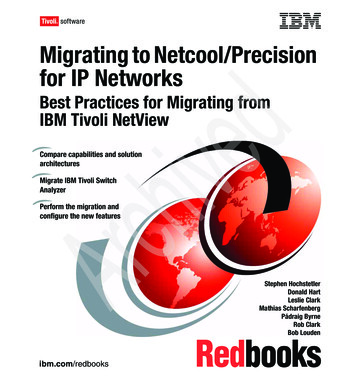
Transcription
Migrating Spartan-6 Designs to7 Series & BeyondAdam Taylorwww.adiuvoengineering.comComplex Engineering Made Simple
Migration from Spartan-6 Designs to 7 Series and BeyondAbstract – This white paper will outline the challenges and mitigation strategies which can beimplemented when migrating from a Xilinx Spartan-6 FPGA to a Xilinx 7 series device or beyond.ContentsMigration from Spartan-6 to 7 Series and Beyond . 1Abstract . 1List of Figures . 2Introduction . 3Spartan-6 to 7 Series Architectural Differences . 3Logic Cells - . 3Block RAM . 4DSP . 5Clock . 5Memory Interfaces. 5Transceivers and PCIe . 6Additional New Features. 6Selecting the Most Appropriate Device . 7Tool Chain Changes . 9Inference vs Instantiation – . 9Design Analysis Report (DAR) - . 10Quality of Result Assessment (QoRA) . 10Clock Interaction and Clock Domain Crossing Reports – . 11RTL Migration Example . 15MicroBlaze Migration. 18ISE System Generator Designs . 19Wrap Up . 19References . 191
List of FiguresFigure 1 – Spartan-6 and 7 Series CLB Structure . 4Figure 2 – Spartan-6 and 7 Series Block RAM Blocks . 4Figure 3 – Spartan-6 DSP48A1 and 7 Series DSP48E1 Structures . 5Figure 4 – XADC Structure 7 Series . 6Figure 5 – Device Selection Spartan-6 to 7 Series Flow Chart . 7Figure 6 – Vivado Language Template . 10Figure 7 – Vivado IP Integrator MicroBlaze Block Diagram . 12Figure 8- Vivado Clock Domain Crossing Report . 13Figure 9- Vivado Clock Interaction Report . 13Figure 10 – Design Migration Flow Chart ISE to Vivado and Vitis. 14Figure 11 – Vivado Constraints Wizard . 16Figure 12 – Vivado I/O Assignment Wizard . 17Figure 13 – XPS MicroBlaze Creation for Spartan-6 Implementation. 182
IntroductionThe semiconductor shortage is having significant impacts on the supply chain, and this isespecially true for older nodes such as the 45nm upon which the Spartan -6 device isfabricated. Although there are still challenges with 7 series and UltraScale /UltraScale deliveries, I am informed that more modern nodes exhibit an improved long-term supplysituation.In this white paper, we are going to understand the differences between the Spartan-6 and7 series architectures. We will also discuss how we can select the most appropriate migrationdevice from the 7 series range along with how to migrate the tool chain from ISE to Vivado .This white paper will also examine how best to migrate a range of designs from pure RTL-baseddesigns to those which contain a significant element of IP and softcore microcontrollers such asMicroBlaze within the programmable logic fabric.First introduced in 2009, the Spartan-6 family is based on a 45 nm process and providesdevelopers within the standard LX version 3.8K and 147K logic cells, up to 576 I/O, 180 DSPslices, and 268 18Kb block RAMS. The transceiver enabled LXT versions provides the logicresources of the LX family and provide up to eight GTP transceivers and 1 PCI Express endpoint.Both the LX and LXT range of devices provide hard integrated memory controllers, whichsupport DDR, DDR2, DDR3, and LPDDR with data rates up to 800 Mb/s.Introduced in 2010, the 7 series consist of five families of devices including the Virtex -7,Kintex -7, Artix -7, Zynq -7000, and Spartan -7. This range of families in the 7 seriesprovides developers sufficient capacity, capability, and performance to migrate a Spartan-6device but also enables significant opportunity for future product enhancement.Spartan-6 to 7 Series Architectural DifferencesLogic - The fundamental element of an FPGA is the logic cell. Both the Spartan-6and 7 series have a function generator which consists of a six input Look Up Table (LUT) withtwo associated flip flops. Several of these function generators and flip flop structures arecombined to create a slice. Each slice contains eight function generators and 16 flip flops. Within7 series devices, there are two types of slices -- Slice M and Slice L. The LUT within theSlice M can act as distributed memories or shift registers. This is not possible within Slice L.Architecturally, two slices are combined to create a configurable logic block.While Slice M and Slice L are identical between the Spartan-6 and 7 series devices,Spartan-6 devices also have a Slice X. Slice X is the most basic logical structure of the threeslice configurations. Functions that were implemented using a Slice X can be easilyaccommodated within the Sli global buffers but iclock is root clock.In Vivado, we would use the XDC create clock commandcreate clock -period 8.000 -name CLK 125MHz p -waveform {0.000 4.000} [get portsCLK 125MHz p]When I migrated the design to Vivado, I accounted for the slight difference in how Vivadoanalyzes clocks compared to ISE. Vivado assigns time zero to the point at which the clock isdefined and ignores all delays upstream of the declaration point. As such, clocks should bedefined at the primary input pins. If a clock is created in a design logic (e.g., counter, DCM etc.),that should be defined using the create generated clock constraint.If you are concerned about which clock constraint to use, you don’t need to write the constraintby hand in Vivado. You can use the Timing Wizard in Vivado (under the tools menu) once thesynthesis has been completed. The timing wizard will walk you through the creation of a targetconstraint file (XDC) while the definition of constraints will save to the target constraints file.15
Figure 11 – Vivado Constraints WizardWith the timing issues addressed, the final stage of the migration of this design is to port theI/O constraints from the UCF to the XDC file. The current definition in the UCF is as follows:NET Din2 pNET Din2 nNET Sin2 pNET Sin2 nLOC "M16" IOSTANDARD LVDS 33 DIFF TERM "TRUE";LOC "M18" IOSTANDARD LVDS 33 DIFF TERM "TRUE";LOC "L17" IOSTANDARD LVDS 33 DIFF TERM "TRUE";LOC "L18" IOSTANDARD LVDS 33 DIFF TERM "TRUE";Again, we need to convert these to a XDC format suitable for use with Vivado. If desired, we canwrite a XDC file by hand in the existing XDC file created for the project.set property IOSTANDARD LVDS 25 [get ports Din1 p]set property IOSTANDARD LVDS 25 [get ports Din1 n]set property IOSTANDARD LVDS 25 [get ports Din2 p]set property IOSTANDARD LVDS 25 [get ports Din2 n]set property PACKAGE PIN A3 [get ports Din1 p]set property PACKAGE PIN A5 [get ports Din2 p]16
Alternatively, can use the I/O Ports tab in the synthesis view to define the pin allocation, I/Ostandard, and any other I/O required features if you are unsure of the exact format. Like thetiming information, this will be saved to the target XDC file which can be inspected tounderstand the XDC syntax.Figure 12 – Vivado I/O Assignment WizardWe can now build and implement the project and generate the bit stream that is ready for portingto the new target 7 series device. Of course, this is a relatively straightforward port of astraightforward RTL design.17
MicroBlaze MigrationMany Spartan-6 designs include a MicroBlaze softcore processor which performs sequentialprocessing implementing UART communications, network stacks, and human machineinterfacing.Within the Spartan-6 MicroBlaze ecosystem, solutions are developed using Xilinx Platform Studioto create the processor and the Software Development Kit (SDK) to create the applicationsoftware. While XPS does provide the ability to create MicroBlaze solutions using AXIinterconnects, most Spartan-6 MicroBlaze designs are implemented using older interfacestandards which are the Processor Local Bus (PLB) and Local Memory Bus (LMB). Thesebusses are used to connect the MicroBlaze to peripheral interfaces like UART and GPIO, alongwith memories such as on chip BRAM and external DDR.Figure 13 – XPS MicroBlaze Creation for Spartan-6 ImplementationOf course, many MicroBlaze solutions contain custom IP cores which perform applicationspecific functions. This custom peripheral needs to be updated to support AXI interfacing if notalready supported. The updated IP can be reused in the updated Vivado project and connectedto the MicroBlaze processor.Migrating a Spartan-6 design that contains a MicroBlaze to a 7 series device requires moreporting than a pure RTL design but also offers potentially more capability and design reuse.To get started porting a Spartan-6 MicroBlaze design to a 7 series device, we must first recreatethe MicroBlaze design in the Vivado IP Integrator. This enables a MicroBlaze processor to beimplemented and connected to the necessary library IP in an integrated environment. The VivadoIP Integrator is not only board aware, enabling peripherals to be configured for specific boardconfigurations such as DDR memories, UARTs, PCIe interfaces, but it’s also able to automateconnections between AXI interfaces to accelerate solution development.When dealing with MicroBlaze applications, engineers must also address a change in softwaredevelopment tool from SDK to Vitis. Vivado will provide the Xilinx Shell Archive (XSA) whichenables Vitis to create a platform including a board support package of APIs to enable SWdevelopers to interface and work with the IP peripherals within the design.18
The software application from SDK must be imported into Vitis and updated to support the newIP peripherals. Vitis makes upgrading easier by allowing an exported SDK project to be importedinto Vitis.ISE System Generator DesignsSome designs in Spartan-6 FPGAs may be developed using ISE System Generator. Like MicroBlazesolutions, these designs are best migrated by recreating the design in Model Composer in Vivado.Like the MicroBlaze solution, there are several reasons for this including a change in available IPcores and migrating to AXI interfacing on IP blocks.The easier migration path is therefore recreating where the ISE System Generator design is used as areference design to support the creation in Model Composer.Wrap UpDevelopers needing to convert a design from Spartan-6
3. Size of the Spartan-6 Device - We can fit the device in a Spartan-7 device if the Spartan-6 device does not use transceivers and is a smaller device than the XCS6LX100. However, we need to consider a device from the Artix family if the Spartan-6 device for migration is larger. Figure 5 - Device Selection Spartan-6 to 7 Series F low C hart

